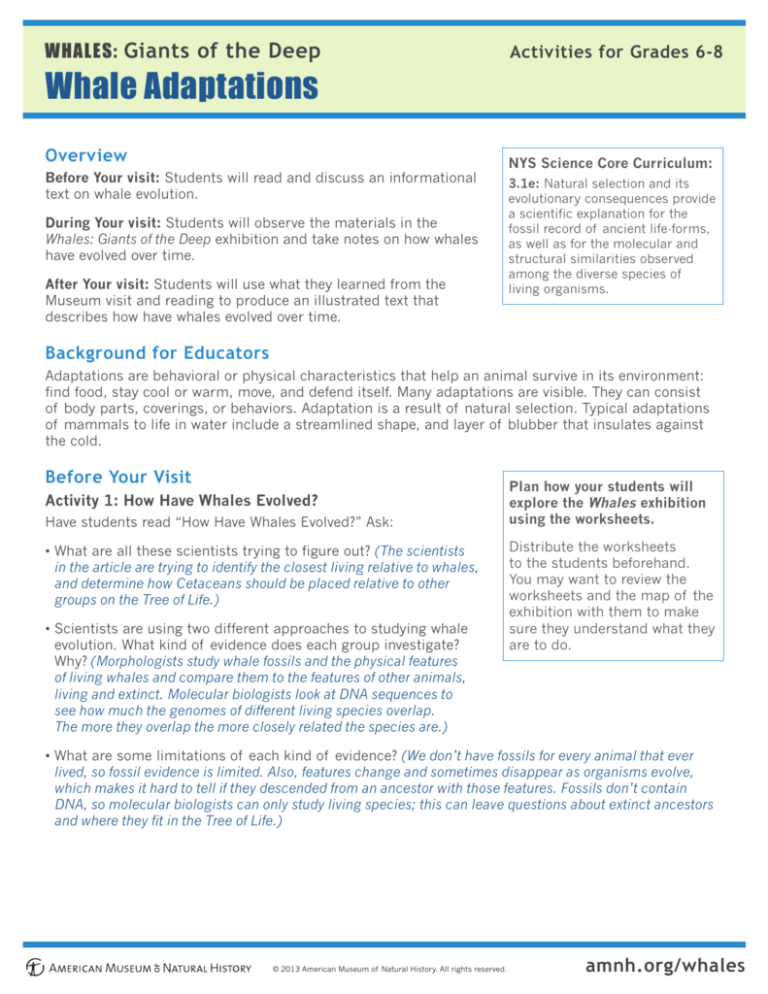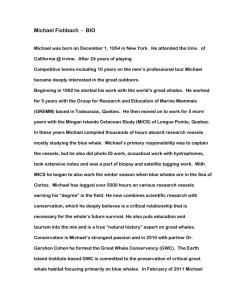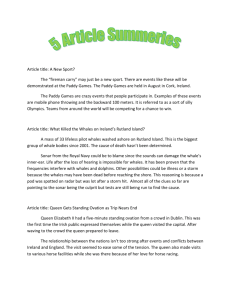
WHALES: Giants of the Deep
Activities for Grades 6-8
Whale Adaptations
Overview
Before Your visit: Students will read and discuss an informational
text on whale evolution.
During Your visit: Students will observe the materials in the
Whales: Giants of the Deep exhibition and take notes on how whales
have evolved over time.
After Your visit: Students will use what they learned from the
Museum visit and reading to produce an illustrated text that
describes how have whales evolved over time.
NYS Science Core Curriculum:
3.1e: Natural selection and its
evolutionary consequences provide
a scientific explanation for the
fossil record of ancient life-forms,
as well as for the molecular and
structural similarities observed
among the diverse species of
living organisms.
Background for Educators
Adaptations are behavioral or physical characteristics that help an animal survive in its environment:
find food, stay cool or warm, move, and defend itself. Many adaptations are visible. They can consist
of body parts, coverings, or behaviors. Adaptation is a result of natural selection. Typical adaptations
of mammals to life in water include a streamlined shape, and layer of blubber that insulates against
the cold.
Before Your Visit
Activity 1: How Have Whales Evolved?
Have students read “How Have Whales Evolved?” Ask:
•W
hat are all these scientists trying to figure out? (The scientists
in the article are trying to identify the closest living relative to whales,
and determine how Cetaceans should be placed relative to other
groups on the Tree of Life.)
•S
cientists are using two different approaches to studying whale
evolution. What kind of evidence does each group investigate?
Why? (Morphologists study whale fossils and the physical features
of living whales and compare them to the features of other animals,
living and extinct. Molecular biologists look at DNA sequences to
see how much the genomes of different living species overlap.
The more they overlap the more closely related the species are.)
Plan how your students will
explore the Whales exhibition
using the worksheets.
Distribute the worksheets
to the students beforehand.
You may want to review the
worksheets and the map of the
exhibition with them to make
sure they understand what they
are to do.
•W
hat are some limitations of each kind of evidence? (We don’t have fossils for every animal that ever
lived, so fossil evidence is limited. Also, features change and sometimes disappear as organisms evolve,
which makes it hard to tell if they descended from an ancestor with those features. Fossils don’t contain
DNA, so molecular biologists can only study living species; this can leave questions about extinct ancestors
and where they fit in the Tree of Life.)
© 2013 American Museum of Natural History. All rights reserved.
amnh.org/whales
WHALES: Giants of the Deep
Activities for Grades 6-8
Activity 2: Where Do Whales Belong on the Tree of Life?
Have students read “Understanding Cladograms.” Ask:
•W
hat information about groups of living things is represented in a cladogram? (Answer: The cladogram
shows how closely groups of living things are related to one another by comparing advanced features and
making inferences about the features of shared common ancestors.)
•H
ow can you determine how closely animals on the cladogram are related? (Answer: The more recently
an organism has a shared common ancestor with another organism, the more closely related they are.)
Have students write a short text explaining how scientist’s view about whales’ relationship to the rest
of the Artiodactyl group has changed using the information on the two cladograms from “How Have
Whales Evolved?” as evidence.
During Your Visit
Whales: Giants of the Deep
4th floor, LeFrak Family Gallery (30-45 minutes)
Using
their worksheets, students will:
• Make observations about whale ancestors
• Compare extinct animals to living species
• Find structural evidence for evolution and adaptation in modern whales
Students should focus on the Whale Lab portion of the exhibit that deals with whale evolution, behavior, and anatomy. Please note that the section on feeding is located towards the exhibit exit, near the
whaling history wall; make sure that students include this section in their research. Encourage them
to also investigate the sections on whaling and whale artifacts, although they’re not relevant to this
activity.
Connecting Hall
Hall of Mammals and their Extinct Relatives
Have students visit the Artiodactyl and Cetacean sections of the exhibit (if entering from the Orientation Center, this is on the right-hand side of the hall, past the Mastodons). Have them look at the
cladograms in both sections, and the computer interactive in the Cetacean section; draw their attention to the leg bone that shows the double-pulley ankle of artiodactyls, and the text that goes along
with it. Ask them: Which Cladogram from the class reading does this one resemble more? Ask them to
support their argument with evidence from the exhibit and the cladograms from the reading. (Answer:
The Cladogram in this exhibit is organized like the first, or earlier, cladogram from the reading. In the hall
cladogram, Whales are shown as outside the Artiodactyl group because it is not shown as descending from
an ancestor with the “double-pulley anklebone” advanced feature. This is because, at the time this exhibit
was built, the controversy surrounding the placement of Cetaceans as part of the Artiodactyl group was not
universally accepted as it became later.)
© 2013 American Museum of Natural History. All rights reserved.
amnh.org/whales
WHALES: Giants of the Deep
Activities for Grades 6-8
Back in the Classroom
Activity 1: Sharing Observations
Have student groups present what they learned in Whales: Giants of the Deep to the rest of the class.
On the board, or on chart paper, have students list the animals they took notes on to compile a class
list of all the organisms that were studied, and the features that they labeled in their sketches.
Discuss as a group what students learned about whale evolution overall, taking care to elicit the
descriptions that students wrote on their notes sheets.
Activity 2: Writing Informational Texts About Whale Evolution
Drawing on their reading, their museum visit, and their notes, have each student create a 1-2 page text
that describes how whales have evolved over time, supported by at least one example each of:
• Fossil evidence
• Molecular evidence
• Structural evidence (evidence from modern whale’s bodies)
The text should include sketches of the fossil and structural evidence.
For information on submitting your students’ work to the LeFrak Class of the Month Essay Contest,
go to amnh.org/lefrakessaycontest.
© 2013 American Museum of Natural History. All rights reserved.
amnh.org/whales
WHALES: Giants of the Deep
Grades 6-8
Student Reading: How Have Whales Evolved?
Consider these enormous, intelligent animals. They’re mammals, but they abandoned dry land
over 50 million years ago to recolonize the sea. And they look nothing like the land ancestors
they left behind. They no longer have hair, they’ve lost their back legs completely, and their
front legs have been transformed into flippers that look from the outside more like a fish’s fin
than a forelimb.
How did this extraordinary transition occur? By studying living animals and fossils of extinct
ones, scientists can investigate the process step-by-step over time. They’ve discovered that
whales started out as dog- or pig-like animals.
Fossils and DNA: Two Different Kinds of Evidence
Before the discovery of DNA and the genomic revolution, scientists relied entirely on
morphology — physical features like the shapes of bones or muscles, or the presence of fins
or fur — to figure out how organisms are related to one another. They compare similarities and
differences among both living animals and the fossils of extinct organisms in order to classify
them into species. Then they construct evolutionary trees. Scientists who deal mostly with this
kind of evidence are called morphologists.
Studying ancient extinct animals means dealing primarily with skeletons and the shapes of
bones, since these are the parts of animals that most commonly fossilize. Morphologists
often focus on a particular bone that has a unique shape or structure, and use the presence or
absence of that type of bone to determine whether or not a newly discovered species belongs
in that group. A famous example is the hip-bone of dinosaurs, which has a distinctive hole.
Morphologists make a strong argument that birds are part of the dinosaur group by pointing
out that they have the same shaped hip-bone as dinosaurs like T. rex, down to the hole in
the hip.
In the 1980s, new tools made it possible to use DNA and other molecules to compare the
genomes, or complete sets of genes, of different organisms. The more similar their genomes,
the more closely related the organisms are. DNA can be used to study living organisms or
recently preserved specimens, but not fossils. Scientists who work primarily with DNA
evidence to determine organisms’ evolutionary relationships are called molecular biologists.
The methods are different but the goal is the same: to figure out how closely living and extinct
organisms are related to each other. This kind of research involves choosing at least three
species and identifying features to compare across them. For morphologists, these features
consist of specific physical characteristics; for molecular biologists, they consist of nucleotide
sequences in DNA.
© 2013 American Museum of Natural History. All rights reserved.
amnh.org/whales
WHALES: Giants of the Deep
Grades 6-8
Student Reading Continued
A Mystery in the Whale Tree of Life
Whales, dolphins, and porpoises have long been recognized as being more closely related to
each other than to other mammals. So they are united in a group called Cetaceans (say it:
“si-TEY-shuns”).
Cetaceans are related to Artiodactyls (say it: “ar-tee-oh-DAK-tils”), a group of mammals that
consists of camels, deer, pigs, hippopotamuses, and their living and extinct relatives. These
animals have an even number of digits on their hands and feet: two or four, unlike our five
fingers and toes. Early fossil whales also had even-numbered digits on their feet, which is one
of many features that suggest a relationship to Artiodactyls on the Tree of Life.
The Artiodactyl ankle has
a joint on both the top and
bottom of the ankle-bone,
allowing it more flexibility than
the ankles of non-Artiodactyls.
The bone that morphologists look
at to determine membership in the
Artiodactyl group is the ankle-bone.
In animals like hippos, deer, and pigs,
it has a distinctive “double pulley”
structure that gives it additional
flexibility.
Artiodactyl ankle-bone
As molecular biologists started investigating whale ancestry, they began to find DNA evidence
that cetaceans were more closely related to hippos than any other Artiodactyl. In fact, hippos
seemed to be closer relatives to whales than to other Artiodactyls, such as pigs and deer! This
was evidence that whales should be considered members of the Artiodactyl group.
Molecular biologists continued to find more evidence of this relationship, but morphologists
did not. No fossil Cetaceans had the definitive Artiodactyl anklebone, and living whales have no
ankles at all! So morphologists were reluctant to believe the molecular evidence.
Molecular biologists argued that it was wrong for morphologists to assume that the shape of
the anklebone couldn’t evolve and change, or even disappear, within a group. They insisted
that morphologists not disregard the new molecular evidence.
Only new fossil evidence could end the stalemate.
Look at the diagrams at the end of the reading to
see the two theories of where whales belong on the
Artiodactyl family tree.
© 2013 American Museum of Natural History. All rights reserved.
amnh.org/whales
WHALES: Giants of the Deep
Grades 6-8
Student Reading Continued
New Fossil Evidence
In Pakistan in 2000, University of Michigan professor Philip D. Gingerich discovered the
47-million-year-old Rodhocetus. This fossil whale had fully developed hind limbs and ankles
very much like the Artiodactyls’, down to the pulley at both ends. Other Rodhocetus features,
such as the shape of its skull and ear bones, were also unmistakably whale-like. This helped
convince many morphologists that whales really do belong in the Artiodactyl group.
Further morphological evidence has been uncovered by studying skulls. In hippos, there is
a large gap between the incisors (front teeth). This gap also appears in the teeth of whales’
fossil ancestors, but not in the skulls of others in the artiodactyl group, such as pigs and deer.
This supports the molecular evidence showing that whales and hippos are closely related.
Intermediate fossils — of animals that reflect the transition between life on land to life in
water — are especially interesting to whale paleontologists. Recent excavations in India,
Pakistan, and Egypt have sparked increasing interest. Recently, paleontologists discovered a
fossil of an animal not much bigger than a large dog, called Ambulocetus (Latin for ‘walking’
plus ‘whale’). Ambulocetus had large legs that look like they could support its weight on land.
More fossils finds will help us fill in the story of how these fascinating animals came to inhabit
our planet’s oceans.
An illustration of an articulated skeleton of Rodhocetus.
© Philip Gingerich, illustrations by Doug Boyer and Bonnie Miljour.
© 2013 American Museum of Natural History. All rights reserved.
amnh.org/whales
WHALES: Giants of the Deep
Grades 6-8
Student Reading Continued
Two Theories of the Artiodactyl Family Tree
hippos
camels
deer
camels
double-pulley
ankle
pigs
deer
hippos
modern
whales
New
Artiodactyl
family tree
based on
DNA and
morphological
evidence
Artiodactyls
rodhocetus
& whale
ancestors
Cetaceans
gap between
the incisors
double-pulley ankle
© 2013 American Museum of Natural History. All rights reserved.
Artiodactyls
Old
Artiodactyl
family tree
based on
morphological
evidence
pigs
Cetaceans
whales
amnh.org/whales
WHALES: Giants of the Deep
Grades 6-8
Student Reading: Understanding Cladograms
What is the best way to reconstruct evolutionary history?
Scientists build evolutionary trees using a method called cladistics, in which organisms are
grouped according to shared features. The distribution of features forms a set of nested
groups, in which smaller groups are contained within larger ones. For example, the group
“tetrapods” (animals with four limbs) is contained within the larger group “vertebrates”
because tetrapods, like other vertebrates, have a backbone and a braincase, which are the
defining features of the group called vertebrates. Each group, or clade, is recognized by a
set of such advanced features inherited from a common ancestor. A clade contains all
descendants of the common ancestor.
What is a cladogram?
A cladogram is a visual reconstruction of the evolutionary history of a group of animals,
based on the distribution of newly evolved (“advanced”) features. Cladograms are drawn as
branching diagrams, with the advanced features noted at the appropriate branching points,
or “nodes.” Look at the cladogram below, which shows the evolution of vertebrates.
branch
tip
ray-finned
fishes
amphibians
mammals
birds and
dinosaurs
branching
point/node
backbone
vertebrates
four limbs
tetrapods
watertight
egg
amniotes
branch
clade
advanced feature
© 2013 American Museum of Natural History. All rights reserved.
amnh.org/whales
WHALES: Giants of the Deep
Grades 6-8
Student Reading Continued
What is an advanced feature?
As species evolve, they develop new features, or characteristics. An advanced feature can be
any attribute of an animal, from the shape of its bones and muscles to its genetic chemistry
and DNA. The descendants often diversify and form other groups, and sometimes even lose
the advanced feature, but they all share an ancestor that did possess that feature. For example,
in this cladogram, reptiles are shown in a clade that shares the advanced feature “four limbs;”
but we know that snakes are reptiles without any limbs at all! What this cladogram shows us is
that all reptiles (like mammals and amphibians, but unlike fishes) share an ancestor that did
possess four limbs. The term “advanced” is relative — it does not necessarily mean that the
feature is better than the primitive feature that it evolved from, it merely
appeared later.
What does the cladogram show?
Cladograms show the relatedness of living things. The branches represent the evolutionary
relationship among the organisms shown at the branch tips. The more recently an organism
has a shared common ancestor with another organism, the more closely related they are.
For example, this cladogram shows that mammals and reptiles are more closely related than
mammals and amphibians, because their shared ancestor that had a watertight egg was
more recent than the most recent ancestor of mammals and amphibians that had four limbs.
© 2013 American Museum of Natural History. All rights reserved.
amnh.org/whales
WHALES: Giants of the Deep
Grades 6-8
Student Worksheet
Name:
1. Choose two fossil whale ancestors. Sketch a skeletal feature that changes from the earlier whale to the later one.
Earlier animal name:
Age of fossil:
Later animal name:
Age of fossil:
Describe the feature in each animal and how it changed:
2. Compare the later species above to one of
the living whales for which a skeleton is shown
(pygmy right whale, sperm whale, hector’s
dolphin, or gray beaked whale). Sketch the
same skeletal feature in this animal in the
box to the right. Describe how this feature
appears now:
Living whale name:
3. Sketch what the
whale you chose looks
like when alive. (You can
refer to a model or a
picture from the whale
family tree or the scale
model case.) Label all
the animal’s adaptations
for living in the water.
Add more as you move
through the exhibition.
© 2013 American Museum of Natural History. All rights reserved.
amnh.org/whales








